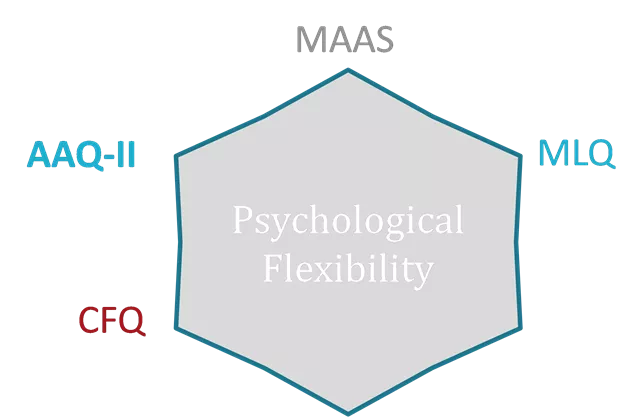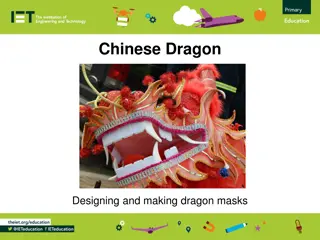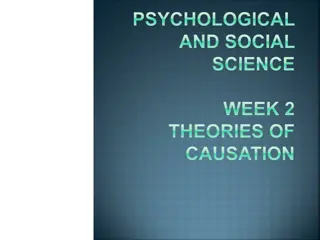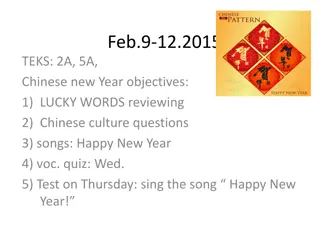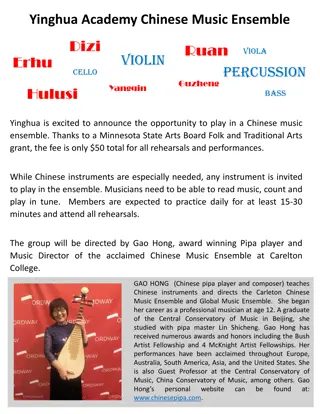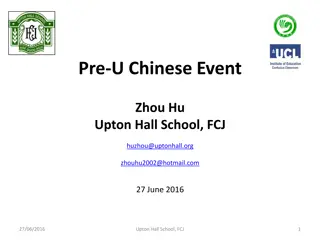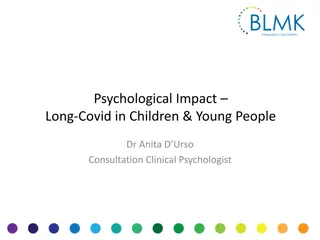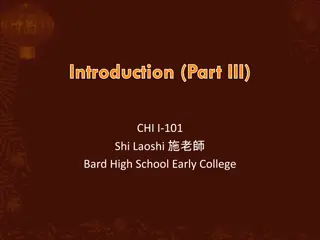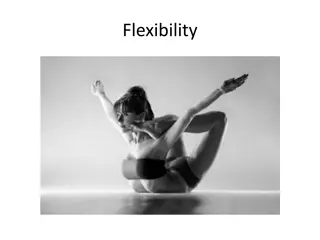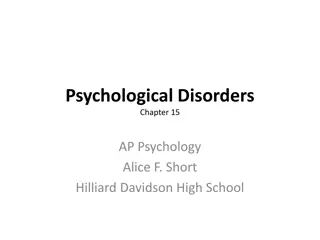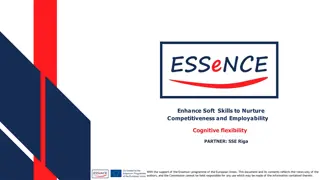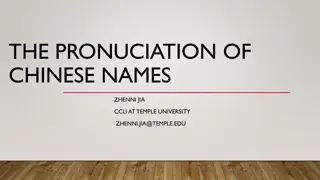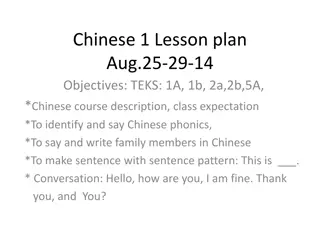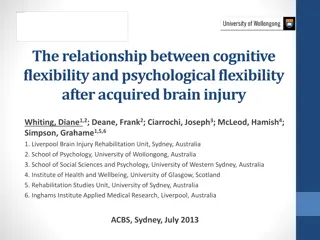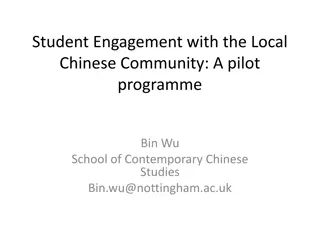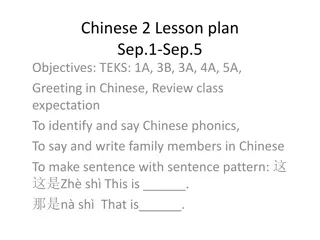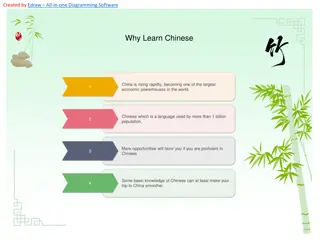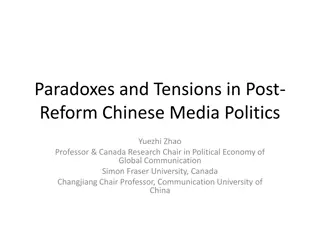Enhancing Psychological Flexibility: Insights from Chinese Psychologists
Exploring the concepts of Psychological Flexibility (PF) and Acceptance and Commitment Therapy (ACT) within the Chinese psychology community. Validating tools like AAQ-II, promoting ACT among counselors, and defining PF for better therapeutic outcomes. Discussion on the comprehensive definition of PF and its application in mental health treatments.
Download Presentation

Please find below an Image/Link to download the presentation.
The content on the website is provided AS IS for your information and personal use only. It may not be sold, licensed, or shared on other websites without obtaining consent from the author. Download presentation by click this link. If you encounter any issues during the download, it is possible that the publisher has removed the file from their server.
E N D
Presentation Transcript
MAAS MLQ AAQ-II Psychological Flexibility CFQ Yang Ji & Prof. Zhuo-Hong Zhu Institute of Psychology Chinese Academy of Sciences
Thank You for Your Support: Including sponsorship from the ACBS SPONSERS, and All the assistances offered by the ACBS TEAM!
+ Brief Intro to ACBS at IoP, CAS + Defining Psychological Flexibility (PF) + Valid the AAQ-II in Chinese Samples + Is PF represented by the AAQ-II? + Discussions and Future Prospects
+ Introducing ACT and RFT to Chinese professionals Zhang Q, Wang SJ, Zhu ZH. 2012 CMHJ Wang SJ, Zhang Q, Zhu ZH. 2012 CMHJ + Validation of ACT related Questionnaires + Finalizing Translation of the 2011 ACT text + Promotion of ACT in Chinese Counselors (Compulsory Content for Registry Examination since 2013) + ACT Mobile Applications
+ ACT has recently gained popularity and elevated its EBP status According to Division 12 of the APA (2006), ACT is currently considered as modestly supported for the treatments of depression, mixed anxiety, obsessive- compulsive disorder, psychosis, and strongly supported for the treatment of chronicle pain. + The PF is the defining model for ACT, better understandings of PF and developments of psychometrics in measuring PF will be a key towards the better validation of the ACT therapy. + Has the PF been well-defined, well-measured or perceived as defined? Lo and Behold!
+ The comprehensive definition well appreciated by the ACBS community: PF = contacting the present moment fully as a conscious human being, and based on what the situation affords, changing or persisting in behavior in the service of chosen values (Hayes) i.e., the Hexaflex (c.f., Hayes, Villatte, Levin, & Hilderbrandt, 2011)
+ Hexaflex Acceptance: enables the individual to engage the experiences more fully with an attitude of curiosity, to learn from them, and to make room for their occurrence. Defusion: making closer contact with verbal events as they really are, not merely as what they say they are. Present Moment Awareness: the voluntary shift of attention that allows one to come into second-by-second contact with life. Self-As-Context: a kind of coming togther of the major classes of deictic relations, such as I/you, here/there, and now/then. Value: constructed by interconnected networks of schemas that is process-focused and intrinsic, which can be assessed in more specific life domains Committed Action: a value based action designed to create a pattern of action that is itself value-based.
BUT Have you heard of what others might have gossiped?
If it is a third wave, it is not a tsunami (2008) Robert L. Leahy American Institute for Cognitive Therapy ACT CBT nothing new Please hold on
In addition to altering cognition, many of the strategies advanced by cognitive theory work to achieve distance from and perspective about one s predicament (2011) D.J.A. Dozois & A.T. Beck ACT CBT an advancement of CBT
? ? ? ? ?
a emotional schema construct Vol. 5, Iss. 4, Special Section: Emotional Schemas, Emotion Regulation, and Psychopathology International Journal of Cognitive Therapy
PAPER NO.1: Processes Underlying Depression: Risk Aversion, Emotional Schema, and Psychological Flexibility 425 psychotherapy patients Multiple regression analyses indicated that depression was best predicted by Risk Aversion and Psychological Flexibility. These findings are discussed in terms of the relative contributions of beliefs about emotional experience and risk tolerance as underlying processes affecting psychological flexibility and depression.
PAPER NO.2: Emotional Schemas, Psychological Flexibility, and Anxiety: The Role of Flexible Response Patterns to Anxious Arousal 295 outpatients presenting for CBT In regression models, emotional schemas regarding control of affect were the primary predictor of elevated BAI scores while psychological flexibility was the primary predictor of elevated anxiety scores on the MCMI-III BAI: Beck Anxiety Inventory MCMI-III: Millon Clinical Multiaxial Inventory
PAPER NO.3: Mindfulness, Psychological Flexibility, and Emotional Schemas 107 adult cognitive-behavioral outpatient Individuals with higher levels of dispositional mindfulness also had higher levels of psychological flexibility and were more likely to endorse more adaptive dimensions of emotional schemas. Those individual who appeared less psychologically flexible or displayed lower levels of dispositional mindfulness were more likely to report less adaptive and more rigid responses to emotional experiences
Assumption that the AAQ-II PF Concluding PF = M = ES based on the significance of multiple regression coefficients Where is the mentioning of theoretical underpinnings? Where is the R2 ?
PF = contacting the present moment fully as a conscious human being, and based on what the situation affords, changing or persisting in behavior in the service of chosen values
+ Rationale: Validating ACT therapy in China first by developing a valid measuring package pertinent to PF + Aim: 1: Validating the AAQ-II in Chinese 2: Test whether the AAQ-II captures fully the elemental constructs proposed by the PF model
+ 1: good psychometric properties of the Chinese AAQ-II in terms of exploratory, confirmatory factor analyses (EFA/CFA), and differential item functioning (DIF). + 2: incremental variance explained by the AAQ-II in comparisons to alternative measures pertinent to the PS model, or relevant psychological constructs.
+ Avoid method effects (Bond et al., 2011) painful experiences and memories to painful experiences to differ this item from painful memories in the other item + Back-translating the 7-item AAQ-II
Sample 1 N = 789 aged between 16 to 26 years (M = 19, SD = 1.64) freshmen at a University in Beijing residence ranged from metropolis (N = 409), medium or smaller sized cities (N = 95), towns (N = 114), and villages (N = 171). Sample 2 N = 238 first year students aged between 17 to 22 years (M = 18.5, SD = .80) from a different department at the same University as Sample 1 194 were retested one month after residence of this sample of students ranged from cities (60.7%), towns (26.5%) or villages (12.8%). + +
Sample 3 N = 220, aged between 20 to 76 years (M = 38.4, SD = 10.8) Employees from a Beijing Based company Education levels were tertiary (61.4%), diploma (14.1%), or secondary Sample 4 N = 350 males officers served more than four years from a military academy base in Beijing age ranged between 19 to 26 years (M = 22.7, SD = 1.3) Sample 5 N = 1662, males (1060), Students at a technical college in regional Sichuan. Age ranged between 14 to 28 years (M = 16.49, SD = 3.78) During the Wenchuan Earthquake 364, 858, 362, 78 students respectively were located at extremely-hit, severely stricken, quake-hit, or unaffected areas in Sichuan according to the official criteria (CNCIDR & MOST; 2008). + + +
+ Psychological Flexibility Processes Value Presence of Meaning Subscale of the Meaning of Life Questionnaire (Steger, 2012) Broader measure of chosen value according to RFT framing Cognitive Fusion Cognitive Fusion Questionnaire (Dempster et al., in press) Present Moment Awareness Mindful Attention Awareness Scale (Brown & Ryan, 2003) + Relevant Construct Rumination Ruminative Response Style Questionnaire(Nolen-Hokesema, 1984) + Unavailable Measures Self-As-Context Committed Actions
+ 1: Validation Principal Component Analysis (Sample 1) Confirmatory Factor Analysis (Sample 2-5) Differential Item Function based on General Response Theory (GRM) Logistic Regression Sample 2 - 4 + 2: Incremental Validity (Sample 1-5) Hierarchical Linear Model (HLM)
+ General Response Theory Descriptive statistics on Item Discrimination and Information
Ui was denoted as a discrete random variable representing the ordered item response to item i, and ui = 0, 1, , mi 1 denote the actual response to item i with mi ordered response categories, where P(ui k) denotes the cumulative properties that the actual item response ui falls in category k or higher. + + The DIF effect is attained by comparing Model 1 with Model 2 for group effects (i.e., uniform DIF), or with Model 3 for group effects and group item interaction effects (i.e., non-uniform DIF). + + +
Did you notice what was missing from the slides?
Another study utilizing behavioral paradigm suggested that high levels of presence of meaning in individuals high in stress may be associated with low levels of psychological flexibility. It could be that the presence of meaning can become fusion at specific instances this however will not elaborated here.
The Chinese AAQ-II obtained sound factor structure and model fit. There are items that were subject to different item functioning among age, gender and groups, nonetheless, the DIF items were not effecting the total scores of the AAQ-II; The AAQ-II correlates highly with construct pertinent to the PS model, as well as levels of various psychological symptoms and life satisfactions; The AAQ-II demonstrated incremental validities in comparisons to most alternative measures, however, it did not show incremental validity to cognitive fusion, presence of meaning, and when it was used to predict life satisfaction at times; The AAQ-II remained a primary predictor for levels of depression and anxiety in multiple regression models including PF related measures, except in the employee sample, when fusion and presence of meaning become more important; The AAQ-II fail to be the primary predictor for life satisfaction; In individual exposed to traumatic events (earthquake), the AAQ-II was positively correlated with presence of meaning, which was not expected by the PF model. + + + + + + +
Implications + A Comprehensive battery for measuring PF according to the hexaflex requires further development; + Value measured by the MLQ-P may not be explaining the original definition of the construct. Value that is cognitive, intrinsic, and domain specific may represent the specific state after the Self-As- Context trainings; Limitations + Measures for constructs such as the Self-As-Context and the Committed Action was not assessed in our study; + Clinical sample were yet to be tested for the PF model in terms of psychopathology; + Social and demographical factors associated with the contextual stress levels of Chinese individuals may bias questionnaire based results, which may be supported by computerized behavioral tests.
MAAS + The Chinese AAQ-II retained sound psychometric properties and can be used for the assessment of levels of PS in future interventional studies, especially, the effectiveness of mobile applications utilizing the framework of ACT therapy. MLQ AAQ-II Psychological Flexibility CFQ




